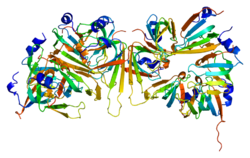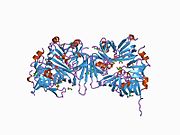Small nuclear ribonucleoprotein polypeptide N
 From Wikipedia the free encyclopedia
From Wikipedia the free encyclopedia
Small nuclear ribonucleoprotein-associated protein N is a protein that in humans is encoded by the SNRPN gene.[4][5]
The protein encoded by this gene is one polypeptide of a small nuclear ribonucleoprotein complex and belongs to the snRNP SMB/SMN family. The protein plays a role in pre-mRNA processing, possibly tissue-specific alternative splicing events. Although individual snRNPs are believed to recognize specific nucleic acid sequences through RNA-RNA base pairing, the specific role of this family member is unknown. The protein arises from a bicistronic transcript that also encodes a protein identified as the SNRPN upstream reading frame (SNURF). Multiple transcription initiation sites have been identified and extensive alternative splicing occurs in the 5' untranslated region. Additional splice variants have been described but sequences for the complete transcripts have not been determined. The 5' UTR of this gene has been identified as an imprinting center. Alternative splicing or deletion caused by a translocation event in this paternally-expressed region is responsible for Prader-Willi syndrome due to parental imprint switch failure.[5]
SNRPN-methylation is used to detect uniparental disomy of chromosome 15.[6] After fluorescent-in-situ-hybridization has confirmed the presence of either SNRPN or UBE3A (a neighboring gene that is also imprinted), the methylation test (of SNRPN) can reveal whether the patient has uniparental disomy. SNRPN is maternally methylated (silenced).[7] UBE3A appears to be paternally methylated (silenced).[citation needed]
References
[edit]- ^ a b c GRCh38: Ensembl release 89: ENSG00000128739 – Ensembl, May 2017
- ^ "Human PubMed Reference:". National Center for Biotechnology Information, U.S. National Library of Medicine.
- ^ "Mouse PubMed Reference:". National Center for Biotechnology Information, U.S. National Library of Medicine.
- ^ Schmauss C, Brines ML, Lerner MR (May 1992). "The gene encoding the small nuclear ribonucleoprotein-associated protein N is expressed at high levels in neurons". J Biol Chem. 267 (12): 8521–9. doi:10.1016/S0021-9258(18)42475-1. PMID 1533223.
- ^ a b "Entrez Gene: SNRPN small nuclear ribonucleoprotein polypeptide N".
- ^ White HE, Durston VJ, Harvey JF, Cross NC (2006). "Quantitative analysis of SNRPN(correction of SRNPN) gene methylation by pyrosequencing as a diagnostic test for Prader-Willi syndrome and Angelman syndrome". Clin. Chem. 52 (6): 1005–13. doi:10.1373/clinchem.2005.065086. PMID 16574761.
- ^ Zeschnigk M, Schmitz B, Dittrich B, Buiting K, Horsthemke B, Doerfler W (1997). "Imprinted segments in the human genome: different DNA methylation patterns in the Prader-Willi/Angelman syndrome region as determined by the genomic sequencing method". Hum. Mol. Genet. 6 (3): 387–95. doi:10.1093/hmg/6.3.387. PMID 9147641.
Further reading
[edit]- Ozçelik T, Leff S, Robinson W, et al. (1993). "Small nuclear ribonucleoprotein polypeptide N (SNRPN), an expressed gene in the Prader-Willi syndrome critical region". Nat. Genet. 2 (4): 265–9. doi:10.1038/ng1292-265. PMID 1303277. S2CID 32755927.
- Schmauss C, McAllister G, Ohosone Y, et al. (1989). "A comparison of snRNP-associated Sm-autoantigens: human N, rat N and human B/B'". Nucleic Acids Res. 17 (4): 1733–43. doi:10.1093/nar/17.4.1733. PMC 331831. PMID 2522186.
- Rokeach LA, Jannatipour M, Haselby JA, Hoch SO (1989). "Primary structure of a human small nuclear ribonucleoprotein polypeptide as deduced by cDNA analysis". J. Biol. Chem. 264 (9): 5024–30. doi:10.1016/S0021-9258(18)83693-6. PMID 2522449.
- Renz M, Heim C, Bräunling O, et al. (1989). "Expression of the major human ribonucleoprotein (RNP) autoantigens in Escherichia coli and their use in an EIA for screening sera from patients with autoimmune diseases". Clin. Chem. 35 (9): 1861–3. doi:10.1093/clinchem/35.9.1861. PMID 2528429.
- Sharpe NG, Williams DG, Howarth DN, et al. (1989). "Isolation of cDNA clones encoding the human Sm B/B' auto-immune antigen and specifically reacting with human anti-Sm auto-immune sera". FEBS Lett. 250 (2): 585–90. Bibcode:1989FEBSL.250..585S. doi:10.1016/0014-5793(89)80801-4. PMID 2753153.
- Reed ML, Leff SE (1994). "Maternal imprinting of human SNRPN, a gene deleted in Prader-Willi syndrome". Nat. Genet. 6 (2): 163–7. doi:10.1038/ng0294-163. PMID 7512861. S2CID 39792921.
- Maruyama K, Sugano S (1994). "Oligo-capping: a simple method to replace the cap structure of eukaryotic mRNAs with oligoribonucleotides". Gene. 138 (1–2): 171–4. doi:10.1016/0378-1119(94)90802-8. PMID 8125298.
- Esposito F, Fiore F, Cimino F, Russo T (1993). "Isolation and structural characterization of the rat gene encoding the brain specific snRNP-associated polypeptide "N"". Biochem. Biophys. Res. Commun. 195 (1): 317–26. doi:10.1006/bbrc.1993.2047. PMID 8363612.
- Glenn CC, Saitoh S, Jong MT, et al. (1996). "Gene structure, DNA methylation, and imprinted expression of the human SNRPN gene". Am. J. Hum. Genet. 58 (2): 335–46. PMC 1914536. PMID 8571960.
- Dittrich B, Buiting K, Korn B, et al. (1996). "Imprint switching on human chromosome 15 may involve alternative transcripts of the SNRPN gene". Nat. Genet. 14 (2): 163–70. doi:10.1038/ng1096-163. PMID 8841186. S2CID 20943659.
- Sun Y, Nicholls RD, Butler MG, et al. (1996). "Breakage in the SNRPN locus in a balanced 46,XY,t(15;19) Prader-Willi syndrome patient". Hum. Mol. Genet. 5 (4): 517–24. doi:10.1093/hmg/5.4.517. PMC 6057871. PMID 8845846.
- Buiting K, Dittrich B, Endele S, Horsthemke B (1997). "Identification of novel exons 3' to the human SNRPN gene". Genomics. 40 (1): 132–7. doi:10.1006/geno.1996.4571. PMID 9070929.
- Suzuki Y, Yoshitomo-Nakagawa K, Maruyama K, et al. (1997). "Construction and characterization of a full length-enriched and a 5'-end-enriched cDNA library". Gene. 200 (1–2): 149–56. doi:10.1016/S0378-1119(97)00411-3. PMID 9373149.
- Fury MG, Zhang W, Christodoulopoulos I, Zieve GW (1998). "Multiple protein: protein interactions between the snRNP common core proteins". Exp. Cell Res. 237 (1): 63–9. doi:10.1006/excr.1997.3750. PMID 9417867.
- Yang T, Adamson TE, Resnick JL, et al. (1998). "A mouse model for Prader-Willi syndrome imprinting-centre mutations". Nat. Genet. 19 (1): 25–31. doi:10.1038/ng0598-25. PMID 9590284. S2CID 20124015.
- Kuslich CD, Kobori JA, Mohapatra G, et al. (1999). "Prader-Willi syndrome is caused by disruption of the SNRPN gene". Am. J. Hum. Genet. 64 (1): 70–6. doi:10.1086/302177. PMC 1377704. PMID 9915945.
- Färber C, Dittrich B, Buiting K, Horsthemke B (1999). "The chromosome 15 imprinting centre (IC) region has undergone multiple duplication events and contains an upstream exon of SNRPN that is deleted in all Angelman syndrome patients with an IC microdeletion". Hum. Mol. Genet. 8 (2): 337–43. doi:10.1093/hmg/8.2.337. PMID 9931342.
- Gray TA, Saitoh S, Nicholls RD (1999). "An imprinted, mammalian bicistronic transcript encodes two independent proteins". Proc. Natl. Acad. Sci. U.S.A. 96 (10): 5616–21. Bibcode:1999PNAS...96.5616G. doi:10.1073/pnas.96.10.5616. PMC 21909. PMID 10318933.
- Gray TA, Smithwick MJ, Schaldach MA, et al. (2000). "Concerted regulation and molecular evolution of the duplicated SNRPB'/B and SNRPN loci". Nucleic Acids Res. 27 (23): 4577–84. doi:10.1093/nar/27.23.4577. PMC 148745. PMID 10556313.
- Albuquerque D, Manco L, González L, et al. (2017). "Polymorphisms in the SRNPN gene are associated with obesity susceptibility among Spanish population". J. Gene Med. 19 (5): e2956. doi:10.1002/jgm.2956. hdl:10230/60864. PMID 28387446. S2CID 1860814.



